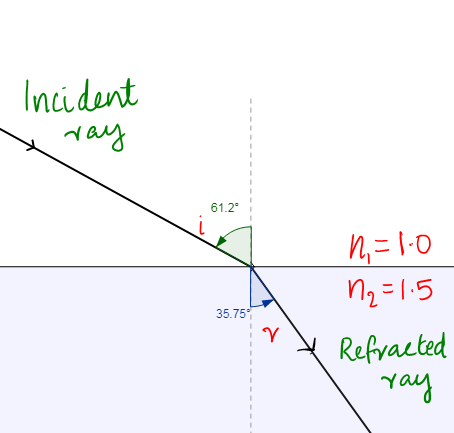
State Snell’s first and second law of refraction.
Answer
512.7k+ views
1 likes
Hint: Refraction deals with bending of light at the interface of two mediums of different refractive index. So the angle associated with the incidence and refraction can have a relation to the refractive index of the two mediums.
Complete step by step answer:

Snell’s First Law: It states that the incident ray, the refracted ray and the normal lie on the same plane.
Snell’s second law: It states that the ratio of the sines of the angles of incidence and refraction is equivalent to the ratio of phase velocities in the two media, or equivalent to the reciprocal of the ratio of the indices of refraction.
Where,
‘r’ is the angle of refraction.
‘i’ is the angle of incidence.
Additional Information:
Snell’s law is responsible for many physical phenomena like mirages, dispersion, apparent depth etc..
In optics, the refractive index of a material is a dimensionless number that describes how fast light travels through the material.
Note: Optical prisms and lenses use refraction to redirect light, as does the human eye. The refractive index of materials varies with the wavelength of light, and thus the angle of the refraction also varies correspondingly. This is called dispersion and causes prisms and rainbows to divide white light into its constituent spectral colors.
Complete step by step answer:

Snell’s First Law: It states that the incident ray, the refracted ray and the normal lie on the same plane.
Snell’s second law: It states that the ratio of the sines of the angles of incidence and refraction is equivalent to the ratio of phase velocities in the two media, or equivalent to the reciprocal of the ratio of the indices of refraction.
Where,
‘r’ is the angle of refraction.
‘i’ is the angle of incidence.
Additional Information:
Snell’s law is responsible for many physical phenomena like mirages, dispersion, apparent depth etc..
In optics, the refractive index of a material is a dimensionless number that describes how fast light travels through the material.
Note: Optical prisms and lenses use refraction to redirect light, as does the human eye. The refractive index of materials varies with the wavelength of light, and thus the angle of the refraction also varies correspondingly. This is called dispersion and causes prisms and rainbows to divide white light into its constituent spectral colors.
Recently Updated Pages
Master Class 9 General Knowledge: Engaging Questions & Answers for Success

Master Class 9 English: Engaging Questions & Answers for Success

Master Class 9 Science: Engaging Questions & Answers for Success

Master Class 9 Social Science: Engaging Questions & Answers for Success

Master Class 9 Maths: Engaging Questions & Answers for Success

Class 9 Question and Answer - Your Ultimate Solutions Guide

Trending doubts
Draw ray diagrams each showing i myopic eye and ii class 12 physics CBSE

Why do the transition elements have higher enthalpies class 12 chemistry CBSE

What are the advantages of parallel combination over class 12 physics CBSE

What are the causes of overloading class 12 physics CBSE

How do you convert from joules to electron volts class 12 physics CBSE

There is hypertension due to smoking Give scientific class 12 biology CBSE




